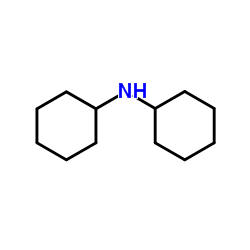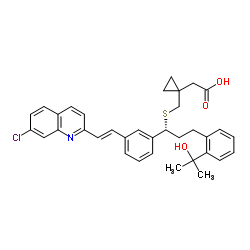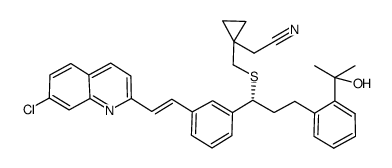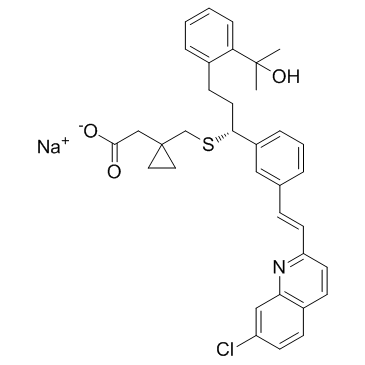577953-88-9
| Name | 1-(((1(R)-(3-(2-(7-chloro-2-quinolinil)ethenyl)phenyl)-3-(2-(1-hydroxy-1-methylethyl)phenyl)propyl)thio)methyl)cyclopropane acetic acid dicyclohexylamine salt |
|---|---|
| Synonyms |
Montelukast Dicyclohexylamine Salt
Cyclopropaneacetic acid, 1-[[[(1R)-1-[3-[(E)-2-(7-chloro-2-quinolinyl)ethenyl]phenyl]-3-[2-(1-hydroxy-1-methylethyl)phenyl]propyl]thio]methyl]-, compd. with N-cyclohexylcyclohexanamine (1:1) {1-[({(1R)-1-{3-[(E)-2-(7-Chloro-2-quinolinyl)vinyl]phenyl}-3-[2-(2-hydroxy-2-propanyl)phenyl]propyl}sulfanyl)methyl]cyclopropyl}acetic acid - N-cyclohexylcyclohexanamine (1:1) |
| Description | Montelukast (MK0476) dicyclohexylamine is a potent, selective and orally active antagonist of cysteinyl leukotriene receptor 1 (CysLT1). Montelukast dicyclohexylamine can be used for the reseach of asthma and liver injury. Montelukast dicyclohexylamine also has an antioxidant effect in intestinal ischemia-reperfusion injury, and could reduce cardiac damage. Montelukast dicyclohexylamine decreases eosinophil infiltration into the asthmatic airways. Montelukast dicyclohexylamine can also be used for COVID-19 research[1][2][3][4]. |
|---|---|
| Related Catalog | |
| Target |
CysLT1 |
| In Vitro | Montelukast (5 μM; 1 h) inhibits APAP (Acetaminophen) (HY-66005)-induced cell damage[1]. Montelukast (0.01-10 μM, 30 min) diminishes the 5-oxo-ETE–induced cell migration and modulates the activation of the plasmin-plasminogen system[3]. Montelukast (10 μM, 18 h) modulates the activation of MMP-9[3]. Cell Migration Assay [3] Cell Line: Eosinophils Concentration: 0.01-10 μM Incubation Time: 30 min Result: Diminished the 5-oxo-ETE–induced cell migration. Western Blot Analysis[3] Cell Line: Eosinophils Concentration: 10 μM Incubation Time: 18 h Result: Reduced the 5-oxo-ETE–boosted MMP-9 secretion. |
| In Vivo | Montelukast (3 mg/kg; oral gavage) protects against APAP-induced hepatotoxicity in mice[1]. Montelukast (1 mg/kg; miniosmotic pump administration) reduces the airway remodeling changes observed in OVA-treated mice and blocks the actions of cysteinyl leukotrienes (LT) C4, D4, and E4 mediated by the CysLT1 receptor[2]. Montelukast (1 mg/kg; miniosmotic pump administration) reduces the elevated levels of IL-4 and IL-13 found in the BAL fluid of OVA-treated mice[2]. Animal Model: C57BL/6J mice (8-week-old; 22-25 g) are induced acute hepatic injury[1] Dosage: 3 mg/kg Administration: Oral gavage 1 h after saline or APAP administration Result: Decreased serum levels of alanine transaminase (ALT) and aspartate aminotransferase (AST), and alleviated liver damage. |
| References |
| Melting Point | 65-67°C (lit.) |
|---|---|
| Molecular Formula | C47H59ClN2O3S |
| Molecular Weight | 767.501 |
| Exact Mass | 766.393494 |
| PSA | 107.75000 |
| LogP | 12.58030 |
| Storage condition | 2-8°C |
| Hazard Codes | Xi |
|---|---|
| RIDADR | NONH for all modes of transport |
| Precursor 10 | |
|---|---|
| DownStream 2 | |



![(1-{(R)-1-{3-[(E)-2-(7-chloro-quinolin-2-yl)vinyl]phenyl}-3-[2-(1-methyl-1-trimethylsilanyloxyethyl)phenyl]propylsulfanylmethyl}cyclopropyl)acetic acid methyl ester structure](https://image.chemsrc.com/caspic/252/1359172-36-3.png)
![2-[2-[(3S)-3-[3-[(1E)-2-(7-Chloroquinolin-2-yl)ethenyl]phenyl]-3-chloropropyl]phenyl]-2-propanol structure](https://image.chemsrc.com/caspic/012/880769-28-8.png)
![2-[1-(Mercaptomethyl)cyclopropyl]acetic acid structure](https://image.chemsrc.com/caspic/092/162515-68-6.png)


![Benzenepropanol, α-[3-[(1E)-2-(7-chloro-2-quinolinyl)ethenyl]phenyl]-2-(1-hydroxy-1-methylethyl)-, 1-methanesulfonate, (αR) structure](https://image.chemsrc.com/caspic/185/920739-17-9.png)


